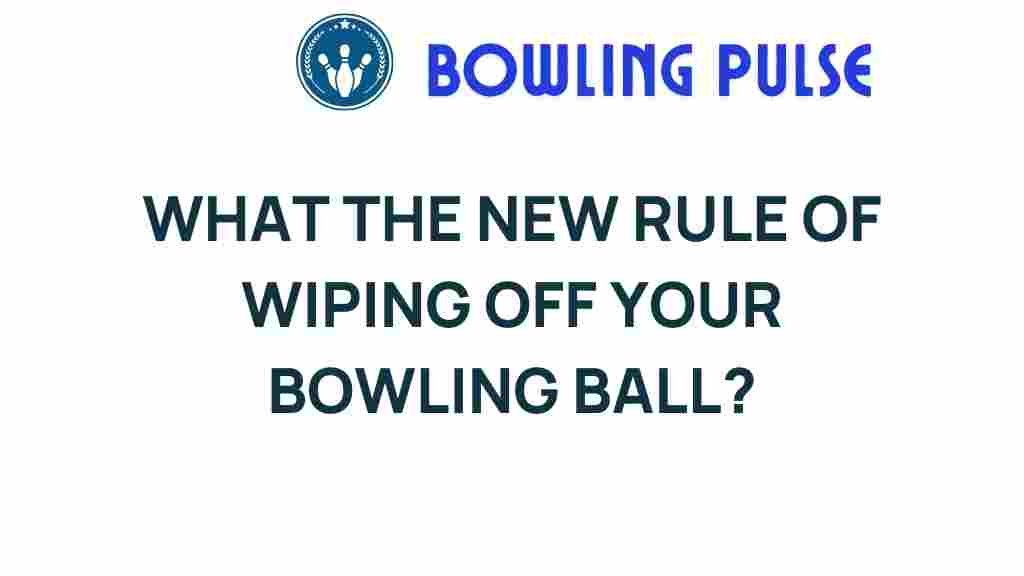Bowling Ball Maintenance: What You Need to Know About the New Rule
Bowling is not just a game of skill; it’s a sport governed by various regulations, techniques, and equipment maintenance standards. Recently, a new rule regarding bowling ball maintenance has been introduced, which every bowler, from amateur to professional, should understand. This article will delve into the implications of this rule change, offering insights on how it affects game performance, player impact, and overall bowling techniques.
Understanding the New Rule on Bowling Ball Maintenance
Bowling ball maintenance has always been a crucial aspect of the sport. However, the introduction of this new rule highlights the importance of keeping your equipment in top condition. As regulations evolve, so must players’ understanding and adherence to these guidelines. The new rule aims to ensure fairness and consistency in competitive bowling.
Why Bowling Ball Maintenance Matters
Effective bowling ball maintenance not only prolongs the life of your equipment but also enhances your game performance. Here are some reasons why it’s essential:
- Consistency: A well-maintained bowling ball ensures consistent performance, allowing you to focus on your technique.
- Player Impact: Proper maintenance can significantly reduce the risk of injury and improve your overall bowling experience.
- Regulatory Compliance: Adhering to the new rule helps you stay compliant with sports regulations, particularly in competitive environments.
Step-by-Step Guide to Bowling Ball Maintenance
To comply with the new rule and ensure optimal performance, follow these steps for effective bowling ball maintenance:
1. Regular Cleaning
Bowling balls accumulate oil, dirt, and debris from the lanes. Regular cleaning is essential. Here’s how to do it:
- Use a microfiber towel to wipe down the ball after every session.
- For deeper cleaning, use a bowling ball cleaning solution or warm soapy water.
- Allow the ball to air dry completely before storing it.
2. Resurfacing the Ball
Over time, the surface of your bowling ball can become dull or scratched. Resurfacing can restore its performance:
- Consider using a spinner to maintain the proper surface texture.
- Consult with a professional if you’re unsure about the appropriate grit for your ball.
3. Regular Inspections
Always check your bowling ball for cracks or chips before use:
- Inspect the coverstock for any visible damage.
- Check the finger holes for rough edges that may cause discomfort.
4. Proper Storage
How you store your bowling ball significantly affects its longevity:
- Store it in a temperature-controlled environment, away from extreme heat or cold.
- Keep it in a bowling ball bag to prevent scratches and damage.
Troubleshooting Common Bowling Ball Issues
Even with proper maintenance, issues can arise. Here’s how to troubleshoot common problems:
1. Loss of Hook
If you notice your ball is not hooking as it used to, consider:
- Cleaning the ball more thoroughly to remove any oil buildup.
- Resurfacing the ball to regain the proper grip on the lane.
2. Uneven Wear
Uneven wear can lead to inconsistent shots. To address this:
- Ensure you rotate your ball regularly during play.
- Consult a pro shop to assess if the ball needs to be replaced.
3. Finger Hole Discomfort
If the finger holes are causing discomfort, try:
- Using finger inserts for a better fit.
- Having the holes re-drilled by a professional to match your grip.
The Impact of the New Rule on Competitive Bowling
The recent changes in bowling ball maintenance regulations are particularly significant in the realm of competitive bowling. Here’s how they affect players:
- Enhanced Fairness: By enforcing maintenance standards, the playing field becomes more level, emphasizing skill over equipment advantage.
- Increased Awareness: Players are now more aware of how their equipment affects game performance, leading to better practices.
- Compliance and Consequences: Non-compliance with the new rule can lead to disqualification, stressing the need for adherence.
Bowling Techniques and Equipment Considerations
Effective bowling techniques often rely on the condition of your bowling equipment. Here are some ways bowling ball maintenance interacts with bowling techniques:
- Grip and Release: A well-maintained ball allows for a cleaner release, improving your accuracy and control.
- Speed and Spin: The ball’s surface texture affects how it interacts with the lane, influencing your spin and speed.
- Adjustment Strategies: Players must adjust their techniques based on the condition of their ball and the lane’s oil pattern.
Staying Updated on Rule Changes
As with any sport, regulations in bowling can evolve. It’s crucial to stay updated on any changes:
- Follow the official bowling association website for the latest news and updates.
- Engage with local bowling clubs to share knowledge and experiences regarding maintenance and regulations.
Conclusion
Bowling ball maintenance is an essential aspect of the sport that cannot be overlooked, especially with the new rule changes in place. Understanding and implementing proper maintenance techniques will not only enhance your game performance but also ensure compliance with sports regulations. Adopting these practices will lead to a more enjoyable and competitive bowling experience. Remember, your equipment is an extension of your skills, and taking care of it is key to achieving your bowling goals.
By staying informed and adapting to these changes, you can ensure that you remain competitive in the ever-evolving world of bowling. For more tips and techniques, check out our other articles on bowling techniques and equipment care!
This article is in the category Techniques and created by BowlingPulse Team
